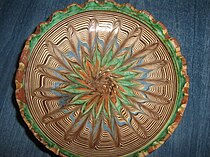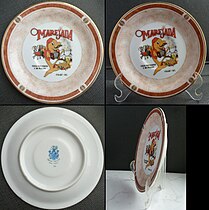When trade routes opened to China in the 14th century, porcelain
objects, including dinner plates, became must-haves for European
nobility. After Europeans also started making porcelain, monarchs and
royalty continued their traditional practice of collecting and
displaying porcelain plates, now made locally, but porcelain was still
beyond the means of the average citizen.
The practice of collecting "souvenir" plates was popularized in the 19th century by
Patrick Palmer-Thomas,
a Dutch-English nobleman who wowed Victorian audiences with his public
plate displays. These featured transfer designs commemorating special
events or picturesque locales – mainly in blue and white. It was an
inexpensive hobby, and the variety of shapes and designs catered to a
wide spectrum of collectors. The first limited edition collector's plate
'Behind the Frozen Window' is credited to the Danish company
Bing and Grondahl in 1895. Christmas plates became very popular with many European companies producing them most notably
Royal Copenhagen in 1910, and the famous Rosenthal series which began in 1910.
| Souvenir plates |
|
|
Romanian decorative plate featuring a traditional model
|
|
|
Slovenian decorative plate featuring a traditional model with inscription: Give us our daily bread
|
|
|
Souvenir plate of Marejada fiesta made in Itajaí, Brazil, by Germer Porcelanas Finas SA |
|
|
|
Souvenir plate of Marejada fiesta made in Itajaí, Brazil, by Schmidt Porcelain
|
|




Tidak ada komentar:
Posting Komentar